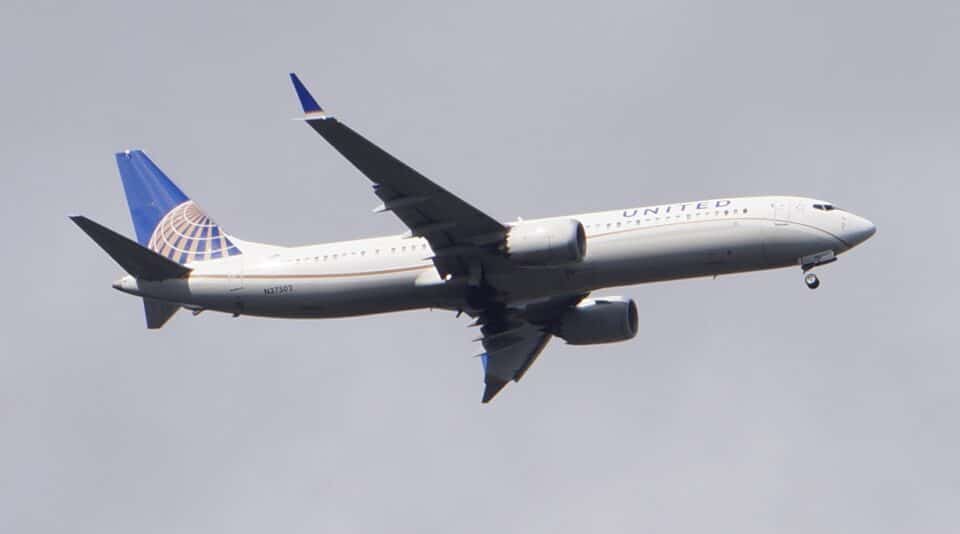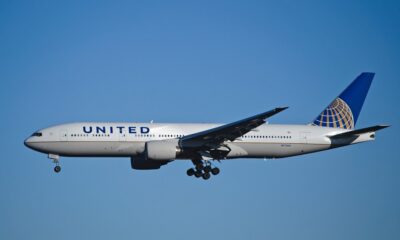Aviation
United Boeing 737 MAX 9 mistakenly landed on RWY 28L rather than 28C at Pittsburgh Airport

The National Transportation Safety Board has launched an investigation to determine how the crew of a United Airlines 737-9 landed on the wrong runway in Pittsburgh last June.
This incident occurred on United Airlines aircraft UA-2627 on June 21st. This service is provided by the airline on a daily basis from Chicago O’Hare International (KORD) in Illinois to Pittsburgh International (KPIT) in Pennsylvania, USA. The flight is usually around an hour long. The flight had 168 passengers and 6 personnel on board on the day of the incident.
Upon initial contact with PIT approach control, the flight crew was told to expect a visual approach to runway 32 into PIT. The flight crew briefed the new approach and proceeded to load the ILS 32 approach into the FMC to back up the visual approach.
While being radar vectored on the downwind and descending through about 4,000 feet Mean Sea level (msl), the flight crew indicated that they had a check landing altitude message displayed briefly on the FMC. After the message disappeared and with the autopilot engaged, the aircraft reverted to control wheel steering pitch mode. They selected level change and reselected the autopilot to command mode.
The airplane began its descent at about 0918 EDT, and as they were descending, approach control asked them if they could accept a visual approach to runway 28C. The weather was clear, and the winds were 250 degrees at 4 knots, so they accepted the runway change. The first officer then re-programmed the FMC for the RNAV GPS Y 28C to back up the visual approach.
The flight crew established communication with the local controller when the airplane was approximately 6. 5 miles east of the airport. They crew advised the controller they were on a visual approach to Runway 28C, to which the controller cleared them to land on Runway 28C. According to the captain, approximately 2 miles from SUPPR, on an intercept heading and while descending, “the screen was black, both FMC’s blanked” except for the aircraft communications, addressing and reporting system (ACARS) prompt and no FMC prompt. The captain used heading select and level change on the mode control panel (MCP). However, when the airplane joined an approximate 6-mile final, it was aligned with Runway 28L.
When the airplane was approximately on a 2-mile final and still aligned with Runway 28L, the flight crew requested verification of their clearance to land on Runway 28C. The controller advised the flight crew of mowing in progress in the grass area and cleared them to land on Runway 28C.
The flight crew read back their clearance to land on Runway 28C.
About 0944 EDT, the airplane landed on runway 28L, turned right off the runway, and exited runway 28L at taxiway F5. The controller noticed the airplane was lined up for runway 28L when it was on short final but decided that it was more appropriate to allow the airplane to land given their altitude. The facility reported that the traffic volume was light with routine complexity. The distance from the airport traffic control tower to the runway 28C threshold was approximately 7,500 feet.
Courtesy : Source

Aerospace
India is set to build a central command for the Air Traffic Control system, called ISHAN

India’s air traffic growth has led to increased responsibilities for air traffic control. The Airports Authority of India (AAI) is considering centralizing air traffic control for aircraft, dividing the country into four regions. The goal is to consolidate India’s segmented airspace into a single entity to improve air traffic management (ATM) efficiency, safety, and smoothness.
Recently, the AAI invited expressions of interest to develop a detailed project report for the Indian Single Sky Harmonized Air Traffic Management (ISHAN) initiative in Nagpur. Under this plan, air traffic controllers in Nagpur would handle domestic flights flying above 25,000 feet, eliminating the need for coordination among controllers in different regions.
For domestic regional flights operating above 25,000 feet, control would shift to the central command in Nagpur. This consolidation aims to enhance airline operations, increase flight handling capacity, and reduce congestion and flight times for passengers.
Currently, the AAI provides ATM services over Indian airspace and adjoining oceanic areas, covering over 2.8 million square nautical miles. This airspace is divided into four flight information regions (FIRs) in Delhi, Mumbai, Kolkata, and Chennai, along with a sub-FIR in Guwahati.
FIRs are responsible for providing air traffic services, including weather information, visibility, and search and rescue assistance. The proposed unification under the ISHAN initiative aligns with the projected growth of the aviation industry, which anticipates a doubling of domestic passenger traffic by 2030.
Aviation
Airbus is set to increase the production rate for the A350 as demand surges

Airbus SE is set to boost production of its advanced A350 widebody jet as it capitalizes on rising demand for long-distance travel and wide-body aircraft, amidst the ongoing crisis affecting its competitor Boeing due to issues with the B737 Max.
The surge in orders for Airbus’s A350 aircraft has instilled confidence in the company, prompting them to ramp up production rates. This move is particularly advantageous as Boeing continues to grapple with production quality issues surrounding its 787 and 777x aircraft.
In 2024 alone, Airbus has received 137 orders for the A350, signaling a need to expand manufacturing capabilities to meet customer demands. With 1,277 orders received and 592 aircraft delivered as of April 2024, Airbus is poised to fulfill pending deliveries efficiently.
The European aircraft manufacturer announced plans to increase production of A350 jets to 12 per month by 2028, surpassing earlier projections aiming for 10 per month by 2026. This decision was disclosed alongside the company’s first-quarter figures.
The Asian market is proving lucrative for the A350, with significant orders from airlines like Indigo and Air India, totaling nearly 70 aircraft commitments for the future. Meanwhile, Airbus is progressing with its A220 and A320 programs, aiming for a monthly production rate of 14 and 75 aircraft, respectively, by 2026. Additionally, the long-range A321XLR is anticipated to commence service in the third quarter of the current year.
In contrast, Boeing has been compelled to scale back production due to regulatory pressures aimed at enhancing factory processes. While Airbus anticipates a positive market outlook, Boeing continues to face challenges with FAA certification and quality approvals, resulting in ongoing delays for its 737 Max and 777x models.
Financially, Boeing reported a significant cash burn of $3.9 billion in the first quarter, leaving it with $7.5 billion in cash and short-term securities by the quarter’s end, down from $16 billion at the beginning of the year. Consequently, Boeing’s stock has plummeted by 38% in the year so far, contrasting with Airbus’s 14% gain, marking Boeing’s lowest performance in over a year.
For a full listing including details on customers and regions, as well as historical data for the previous year, go to the download section below.
- March 2024 deliveries: 63 deliveries to 32 customers
- March 2024 gross orders: 137
- 2024 deliveries to date: 142 deliveries to 45 customers
| Single-Aisle | A300/A310 | A330 | A340 | A350 | A380 | TOTAL | |
|---|---|---|---|---|---|---|---|
| Total Orders | 19470 | 816 | 1774 | 377 | 1277 | 251 | 23965 |
| Total Deliveries | 11705 | 816 | 1598 | 377 | 592 | 251 | 15339 |
| Aircraft in Operation | 11007 | 271 | 1482 | 202 | 591 | 234 | 13787 |
Aviation
All passengers killed in plane crash, after pilot let his children to control the plane

When boarding a plane, passengers entrust their safety to the skilled hands of the pilot. However, tragedy struck when one of the flight ended in disaster as all passengers lost their lives in a horrific plane crash.
In 1994, during a flight from Moscow to Hong Kong, tragedy struck as an Aeroflot relief pilot made a fateful decision. In a move that would have devastating consequences, the pilot invited his own children into the cockpit to play with the controls. Little did anyone know, this seemingly innocent gesture would lead to the loss of all 75 lives aboard the aircraft.
It was a seemingly innocent act that led to catastrophic results. The relief pilot, Mr. Kudrinsky, invited his two children, Yana, 12, and Eldar, 15, into the cockpit during the late hours of the night. Little did anyone know, this simple gesture would set off a chain of events that would end in tragedy.
Once in the cockpit, the children were allowed to sit in the captain’s chair and play with the controls, unaware that they should have been disabled as the plane was in autopilot mode.
Eldar, perhaps in a moment of curiosity or innocence, held the control column down for a mere 30 seconds. Yet, in those brief moments, the autopilot disengaged, thrusting the aircraft into manual control.
By the time the pilots regained their seats and attempted to regain control, it was too late. Despite their efforts to pull the plane out of a dive, they overcorrected, causing the flight to climb almost vertically, ultimately stalling it.
Final moment Flight 593 crash
In the final moments, as the pilots struggled to stabilize the aircraft, Flight 593 crashed into the Kuznetsk Alatau Mountain range in southern Russia, completely obliterating the plane and claiming the lives of everyone on board.
Investigations revealed a chilling truth: there was no evidence of technical failure. Instead, the crash was attributed to the unthinkable decision to allow inexperienced hands to manipulate the controls of a commercial aircraft.
The black box recording captured the harrowing sequence of events, providing a grim reminder of the human cost of a lapse in judgment. In just over two minutes, the lives of all on board were tragically short, leaving behind a legacy of sorrow and unanswered questions.



























